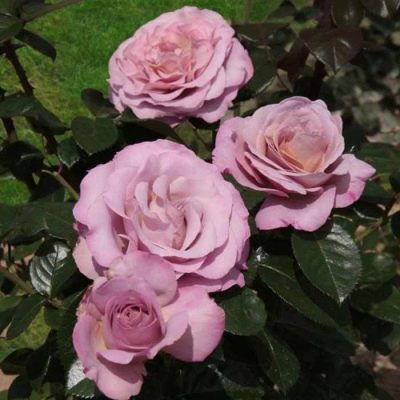
- Authors: Sauvageot
- Name synonyms: Blue Girl, Blue Girl
- Breeding year: 2008
- Group: tea-hybrid
- The main color of the flower: lilac, purple
- Flower shape: cupped
- Flower size: large
- Diameter, cm: 10-12
- Flower type by number of petals: medium terry
- Scent: sweet, fruity
Rose Blue Girl was bred in 2008 in France. It also has the titles Blue Gel and Blue Girl. The species is hybrid tea. It is used for cutting, for the formation of decorative single and group plantings.
Description of the variety
Blue Girl is a dense and erect shrub, the average height of which is 60-70 cm, and the width is 60 cm. The foliage of the variety has a rich dark green color, the surface of the leaves is semi-gloss. All leaves are rather large. This variety has strong peduncles.
The flowers have a beautiful silvery purple color. They are cup-shaped and rather large in size, their average diameter is 10-12 centimeters. The flowers are considered to be medium-sized. The arrangement of flowers is most often solitary, one bud is located on one stem. They have a slight fruity sweet aroma.
Advantages and disadvantages
Rose Blue Girl has many important benefits. So, it is highly resistant to diseases, including powdery mildew and black spot. And also the variety has high frost resistance, it is able to withstand temperatures from -18 to -23 degrees Celsius. This rose has no significant flaws.
Flowering features
Such ornamental vegetation blooms from June until the onset of the first frost. The flowering is quite abundant. The variety is considered to be re-flowering.
First, dark purple buds form on the bushes. They have a goblet shape. Then, over time, they form flowers.
Landing
Planting holes should be prepared in advance. Their depth should be about 40-50 centimeters. You can plant such a rose in early May. For her, a fairly loose and slightly acidic soil will be the best option. A well-lit place for landing should be selected.
Growing and care
After planting, such a hybrid tea rose will need regular watering (once every two to three days). When the flower is fully strengthened, watering is reduced to a moderate mode. After each such procedure, the land around is necessarily mulched. The plant responds well to feeding. In this case, it is better to combine organic and mineral compositions.
The rose also needs sanitary and formative pruning. Despite the fact that the vegetation is highly frost-resistant, it needs preparation for winter. To do this, the soil around the shrubs is mulched, then the plants are covered with a special material. Moreover, it must be positioned in such a way that air flows inside.
Diseases and pests
This rose is very resistant to diseases and parasites. However, she still occasionally suffers from powdery mildew, which affects almost all parts of the shrub. In this case, a whitish bloom forms on the surface.
And also plants can be affected by rust, in which brown ulcers form on the flower, small red-yellow spore pads appear on the underside of the foliage.
To cure vegetation, it is better to immediately use ready-made preparations ("Falcon", "Topaz"). As a preventive measure, treatments with iron and copper sulfate are suitable.
Sometimes various harmful insects settle on the flower, including spider mites, aphids, leaf rollers. In this case, all damaged parts are carefully removed. If there are few pests, they are pre-collected by hand.After that, the affected shrubs are treated with chemicals.
Reproduction
These roses are best propagated early in the summer season. And it is best to do this with cuttings. In this case, the material must be taken from healthy and strong young plantings. In addition, propagation by grafting is possible.
Review overview
According to gardeners, the Blue Girl rose is distinguished by its decorative appearance and beautiful unusual colors. In addition, it was noted that such plants are often sick, although many infections nevertheless appear due to adverse weather conditions, as well as due to improper care.































































